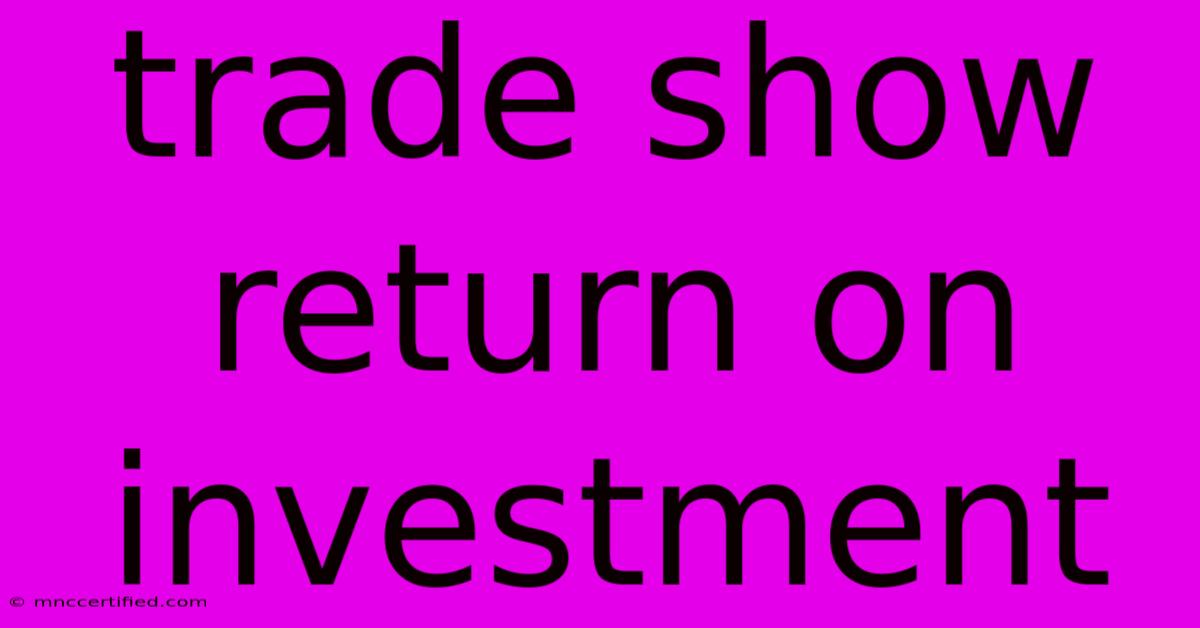Trade Show Return On Investment

Table of Contents
Calculating Your Trade Show Return on Investment (ROI): A Comprehensive Guide
Trade shows can be a significant investment for businesses of all sizes. But are they worth the cost? The key to understanding the value of trade show participation lies in accurately calculating your return on investment (ROI). This comprehensive guide will walk you through the process, helping you determine if your next trade show is a smart financial decision.
Understanding Trade Show ROI: Beyond the Obvious
While many focus solely on immediate sales generated at a trade show, true ROI encompasses a broader picture. It's about measuring the long-term impact of your participation. This includes:
- Direct Sales: These are the sales made directly at the trade show booth. This is the easiest aspect to track, but often represents only a fraction of the total ROI.
- Lead Generation: Collecting qualified leads is crucial. These are potential customers who expressed interest in your products or services. Proper follow-up is critical to converting leads into sales.
- Brand Awareness & Visibility: Trade shows offer unparalleled brand exposure. The sheer number of potential customers and industry influencers in attendance significantly increases your brand's visibility. This is difficult to quantify but incredibly valuable.
- Networking Opportunities: Connecting with industry professionals, potential partners, and key influencers can lead to significant long-term benefits, including collaborations, new partnerships, and enhanced industry reputation.
- Market Research: Trade shows provide a first-hand look at competitor strategies, emerging trends, and customer preferences. This invaluable market intelligence can inform future business decisions.
Calculating Your Trade Show ROI: A Step-by-Step Approach
Accurately calculating ROI requires a meticulous approach. Here's a structured method:
1. Calculate Your Total Investment:
This includes all expenses associated with the trade show:
- Booth Space Rental: The cost of your exhibit space.
- Booth Design & Construction: Costs related to designing and building your booth.
- Marketing Materials: Brochures, flyers, giveaways, etc.
- Shipping & Transportation: Costs of transporting materials and personnel.
- Travel & Accommodation: Expenses for your team's travel and lodging.
- Staffing Costs: Salaries or wages for employees attending the show.
- Lead Capture Technology: Cost of software or hardware for lead generation.
- Entertainment/Promotional Giveaways: Costs associated with any entertainment or promotional items offered at your booth.
Total Investment = Sum of all above expenses
2. Quantify Your Returns:
This involves estimating the monetary value of each return category mentioned earlier:
- Direct Sales: Calculate the total revenue from sales made at the show.
- Lead Generation: Assign a monetary value to each qualified lead based on your historical conversion rates. (e.g., if 10% of leads convert into sales with an average sale value of $1000, each lead is worth $100).
- Brand Awareness (Qualitative Assessment): While difficult to quantify precisely, consider the value of increased brand visibility and how this might translate to future sales or partnerships. This section can be a subjective estimate based on pre- and post-show brand awareness analysis.
3. Calculate Your ROI:
The formula for ROI is:
ROI = (Total Returns - Total Investment) / Total Investment x 100%
This will provide you with a percentage representing your return on investment. A positive ROI signifies profitability; a negative ROI indicates a loss.
Improving Your Trade Show ROI: Key Strategies
Several strategies can help maximize your trade show ROI:
- Targeted Marketing: Pre-show marketing campaigns focused on attracting your ideal customer profile.
- Engaging Booth Design: A visually appealing and interactive booth that attracts visitors.
- Well-Trained Staff: Ensure your staff is knowledgeable, friendly, and effectively engages with potential customers.
- Lead Qualification & Follow-Up: Implement a robust lead capture and follow-up system to convert leads into sales.
- Post-Show Analysis: Thoroughly analyze the results of the trade show to identify areas for improvement for future events.
Conclusion: Making Informed Decisions
Calculating your trade show ROI is essential for making informed decisions about future participation. By carefully tracking your expenses and returns, and implementing the strategies outlined above, you can significantly increase the profitability of your trade show investments and contribute to your overall business success. Remember that a comprehensive ROI calculation goes beyond immediate sales and considers the long-term impact of your participation. This holistic approach provides a more accurate picture of your trade show's true value.

Thank you for visiting our website wich cover about Trade Show Return On Investment. We hope the information provided has been useful to you. Feel free to contact us if you have any questions or need further assistance. See you next time and dont miss to bookmark.
Featured Posts
-
Outlook Microsoft Services Back Online
Nov 26, 2024
-
Valley Activities Weekly Events Guide
Nov 26, 2024
-
51 Year Old Dan Hurley Pre Game Free Throws
Nov 26, 2024
-
Egypt Nile Cruise A Canadians Guide
Nov 26, 2024
-
Chief Investment Officer Search
Nov 26, 2024